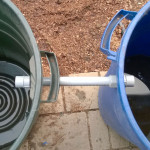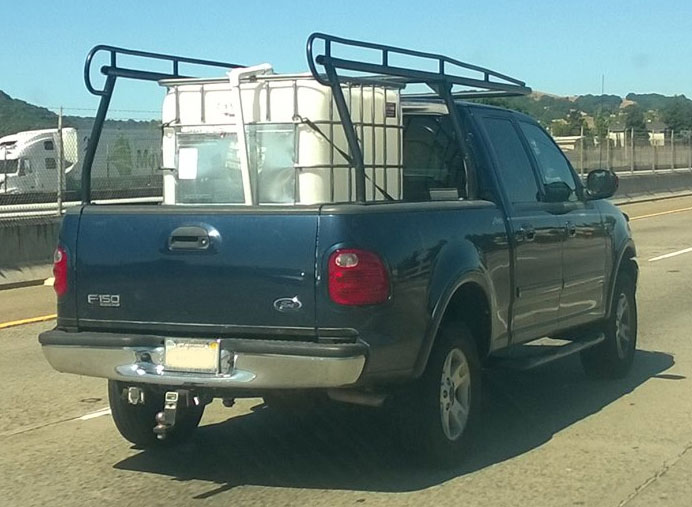 Capturing rainwater is easy to do. All you need is rain and a bucket. Capturing rainwater for re-use in the yard becomes helpful when using large containers and rain gutters from your roof. A 1,000 square foot roof will capture about 625 gallons of water when an inch of rain falls. For a 1/4″ to 1/2″ rain storm, those totals can quickly add up to 150-300 gallons of water, significantly more than my rain barrels hold.
Capturing rainwater is easy to do. All you need is rain and a bucket. Capturing rainwater for re-use in the yard becomes helpful when using large containers and rain gutters from your roof. A 1,000 square foot roof will capture about 625 gallons of water when an inch of rain falls. For a 1/4″ to 1/2″ rain storm, those totals can quickly add up to 150-300 gallons of water, significantly more than my rain barrels hold.
When its not raining and the barrels are full, it becomes an excellent source of water for irrigating the plants in the yard, providing savings on potable water use at home. Plus, rainwater doesn’t have all the chemicals in it that you find in the normal drinking water supply.
To illustrate this point I built a quick and easy rainwater harvesting system with passive overflows and the ability to intertwine a few rain barrels together. Also, once the bins are empty, I can quickly and easily disconnect the piping and put the barrels back in storage.
Materials Required:
- 1″ spade drill bit
- 3/4″ flex elbow
- 3 – 3/4″ female threaded coupling
- 3/4″ Liquidtite 90° Fitting Connector
- 3/4″ flexible conduit
- 2 – Trash Bins (I used 32 gallons bins)
Tools Required:
- Drill for spade drill bit
I already had two 32 gallons trash bins that I used last year for rainwater harvesting. This year I needed a more passive solution to get water into the other bin and had a build in overflow to a garden bed. To do that I came up with this solution to building a better rain barrel. Setup was very easy, took less than 5 minutes and is water tight. Ironically, I found electrical fittings to be the easiest to work with. I already had a lot of these parts laying around so setup was fairly cheap.
 First step after acquiring the parts listed above was to drill a hole in the side of the first bin. This hole will be used for connecting the two bins together so when water fills up the first barrel it will overflow into the second. This hole should be about 3″ from the top of the barrel lip.
First step after acquiring the parts listed above was to drill a hole in the side of the first bin. This hole will be used for connecting the two bins together so when water fills up the first barrel it will overflow into the second. This hole should be about 3″ from the top of the barrel lip.
Now drill a hole at the same level on the second barrel. Get them as close to the same position so that when you install your flex elbow conduit water will flow from one bin to the other. It doesn’t have to exactly level, just close enough so it won’t overflow when its raining.
If you’re using 3/4″ parts like I mentioned in the materials list, then your drill bit will need to be a 1″ drill bit. Take my word for it, it works.
 Second, insert one end of the flex elbow into the hole, as seen pictured on the right. It may be a little tough but it will go through the hole. The subset image on the left shows the threads poking through the hole. The flex elbow I bought came with black o-rings which I placed between the connector and the walls of the bin. This helped to create a water tight seal.
Second, insert one end of the flex elbow into the hole, as seen pictured on the right. It may be a little tough but it will go through the hole. The subset image on the left shows the threads poking through the hole. The flex elbow I bought came with black o-rings which I placed between the connector and the walls of the bin. This helped to create a water tight seal.
Perform the action on both bins.
 When done, screw on the female threaded couplings. This should secure the flex elbow in place.
When done, screw on the female threaded couplings. This should secure the flex elbow in place.
Now the bins are connected, you can carefully move them around with relative ease and you can also disconnect one side for easy maneuverability when not in use.
 Assemble the 90° threaded to compression watertite fitting to the 3/4″ flexible conduit as seen on the table. I had excess conduit from other house projects so I used that.
Assemble the 90° threaded to compression watertite fitting to the 3/4″ flexible conduit as seen on the table. I had excess conduit from other house projects so I used that.
I chose the barrel that would not be directly under the downspout and was also closest to the drain in the backyard. This barrel would have the overflow pipe attached to it.
 Drill a hole in one of them bins for the overflow. Drill this hole as close the top as you can, about 1″ below the top rim. This enables both of your rain barrels to be nearly full before water will passively overflow the drain pipe to the ground. As you can see in the image on the left, the overflow hole is near the top rim, higher than the overflow hole on the opposite side of the barrel.
Drill a hole in one of them bins for the overflow. Drill this hole as close the top as you can, about 1″ below the top rim. This enables both of your rain barrels to be nearly full before water will passively overflow the drain pipe to the ground. As you can see in the image on the left, the overflow hole is near the top rim, higher than the overflow hole on the opposite side of the barrel.
Insert the threaded end of the elbow into the hole and screw on another female threaded coupling.
When done, the bins will tied together in the middle with flexible conduit and there will be a passive overflow to the ground.
This last image shows the overflow from one barrel to the other in action.
This was very easy to setup. I only have two barrels in my setup, I can hold about 62 gallons of water which is easy to achieve with smaller storms. I use the water in a watering can to water potted plants around the yard. 62 gallons of water can usually last a week or so depending on watering needs. Definitely easy to setup and worth doing if you have a spare shed or outdoor living room with a roof and gutter setup.





Leave a Reply